Step back in time to the Fall of
1621. You’re standing in a small settlement about an hour south of
Boston near what’s today Plymouth, Massachusetts. It doesn’t seem
like any special day. Many of the villagers are going about their
daily chores while others prepare their homes for the coming winter.
The smell of wood fires fills the air and with it the tantalizing
smells of roasting meat. Though you don’t know it, the villagers,
whom we’ve come to know as Pilgrims, are preparing for a harvest
feast to celebrate their bountiful crops.
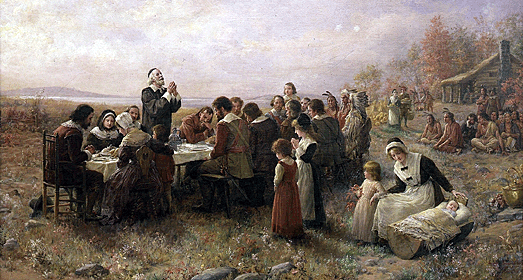
Today's Thanksgiving celebration isn’t anything like what you’re
about to experience in this 17th-century recreation of the Pilgrim’s
original settlement, known as Plimoth Plantation. Within this living
history site, actors play the roles of Pilgrims and Indians who
lived in the settlement or nearby. The actors, each portraying real
people who lived in the village, attempt to preserve an accurate
representation of Pilgrim life in the early 17th century.
Thanksgiving is a blend of several earlier traditions—the New
England custom of rejoicing after a successful harvest, a solemn
religious observance combining prayer and feasting, and finally, the
commemoration of the Pilgrims' landing known as Forefathers' Day.
Celebrations combining sacrifices, rituals and joyful reveling after
a successful crop gathering are as old as the harvest itself. Thus,
in 1621 when a bountiful harvest rewarded the Pilgrims after a year
of sickness and scarcity, they gave thanks to God and celebrated His
bounty in the Harvest Home tradition in which they had been brought
up. To these people of strong Christian faith, this wasn’t merely a
revel—it was a joyous outpouring of gratitude.
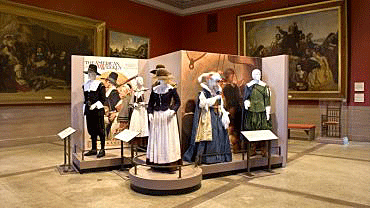 While
the Pilgrims were a reverent group of believers, they didn’t wear
black nor were they somber and sad as history has portrayed them.
Like their contemporaries back in England, they dressed in colored
clothing, not just black, white, and gray, and they wore what was in
style at the time. And while Thanksgiving decorations and depictions
show the Pilgrims wearing buckles on their belts and shoes, they
weren’t actually used until the late 18th century.
While
the Pilgrims were a reverent group of believers, they didn’t wear
black nor were they somber and sad as history has portrayed them.
Like their contemporaries back in England, they dressed in colored
clothing, not just black, white, and gray, and they wore what was in
style at the time. And while Thanksgiving decorations and depictions
show the Pilgrims wearing buckles on their belts and shoes, they
weren’t actually used until the late 18th century.
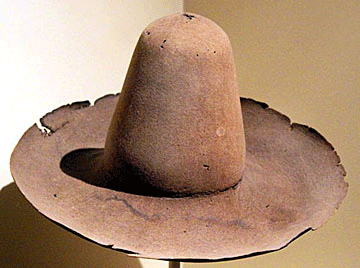 They
drank beer, considered more nourishing than water, laughed, worried,
and worked hard. The Pilgrims regularly played rustic sports,
feasted, and entertained themselves through singing and such. And a
few managed to get punished for quarreling and public drunkenness.
In short, they were just like many of the other settlers who came to
the New World.
They
drank beer, considered more nourishing than water, laughed, worried,
and worked hard. The Pilgrims regularly played rustic sports,
feasted, and entertained themselves through singing and such. And a
few managed to get punished for quarreling and public drunkenness.
In short, they were just like many of the other settlers who came to
the New World.
To the Puritans of early New England, a true "Thanksgiving" was any
day of prayer and pious humiliation, thanking God for His Providence
or for some auspicious event. It was like an extra Sabbath during
the week. This sort of solemn event was what early colonial
governors intended when declaring a day of thanksgiving.
 The
Pilgrims had had a terrible first year but those that remained—only
50 remained alive out of 100—had recovered and regained their
strength. Everyone did their part. Some fished for cod and bass,
which they took in great quantities so that every family received
their allotted portion. Throughout the summer there was no want and
as fall began, the governor sent out four men to hunt for ducks,
geese, and swans for the winter. And besides waterfowl, they bagged
a great number of wild turkeys and some venison as well to prepare
for the harvest feast. The Pilgrims refrained from including
lobsters in their menu since they were so easy to catch, most
considered them food for the poor. They also had a good crop of
Indian corn which they ground up and made into corn meal.
The
Pilgrims had had a terrible first year but those that remained—only
50 remained alive out of 100—had recovered and regained their
strength. Everyone did their part. Some fished for cod and bass,
which they took in great quantities so that every family received
their allotted portion. Throughout the summer there was no want and
as fall began, the governor sent out four men to hunt for ducks,
geese, and swans for the winter. And besides waterfowl, they bagged
a great number of wild turkeys and some venison as well to prepare
for the harvest feast. The Pilgrims refrained from including
lobsters in their menu since they were so easy to catch, most
considered them food for the poor. They also had a good crop of
Indian corn which they ground up and made into corn meal.
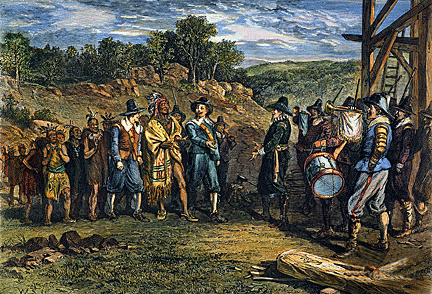 The
governor invited the Indians to the settlement. Among them was their
greatest king Massasoit, with some 90 men, who the Pilgrims feasted
and entertained for three days. For their contribution, the Indians
went out and killed five deer, which they brought to the plantation
and gave to the villagers.
The
governor invited the Indians to the settlement. Among them was their
greatest king Massasoit, with some 90 men, who the Pilgrims feasted
and entertained for three days. For their contribution, the Indians
went out and killed five deer, which they brought to the plantation
and gave to the villagers.
Trenchers, small square or round wooden plates, took the place of
dinner plates, and some-times two people shared one. Forks weren't
used until 1630. Before that the Pilgrims ate with knives and a few
spoons. Because they used their hands to serve the food and to eat
with, each person had a huge, three-foot-square cloth slung over his
or her shoulder.
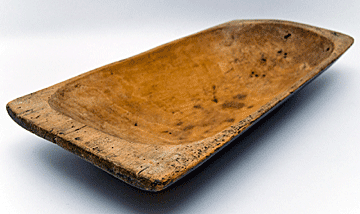 Another
misconception was that 17th-century cooking was bland. Spices came
aboard the Mayflower. The cooks in the 17th century put nutmeg and
ginger into many of their dishes.
Another
misconception was that 17th-century cooking was bland. Spices came
aboard the Mayflower. The cooks in the 17th century put nutmeg and
ginger into many of their dishes.
Beyond this bit of information, there are few written accounts of
that first Thanksgiving.
Early Thanksgiving Proclamations
The Continental Congress proclaimed the first national Thanksgiving
in 1777. This was meant to be a somber event, and Congress
recommended that people refrain from work and recreation that may be
unbecoming the purpose of this day.
Presidents Washington, Adams, and Monroe also proclaimed national
days of Thanksgiving, but the custom fell out of favor after 1815.
In 1827, Mrs. Sara Josepha Hale, a writer who had composed the
nursery rhyme “Mary Had a Little Lamb,” and later editor of Godey's
Lady's Book, began a campaign to reinstate the holiday by
petitioning several succeeding Presidents to make it an annual
event.
But it wasn’t until 1863, when President Lincoln declared two
Thanksgivings, one for Thursday, August 6, and a second for the last
Thursday in November, that it became an official holiday. From that
time on, every succeeding President declared some Thursday in autumn
Thanksgiving Day. Eventually, Lincoln's choice of the last Thursday
in November became the traditional date.
The Pilgrims Redefined
It was about this time in the late 19th century that the third
element—commemoration of the Pilgrims—entered the Thanksgiving
picture. While interest in the Pilgrims as historic figures began
shortly before the Revolution, it wasn’t until the Philadelphia
Exposition of 1876, commemorating the centennial of the Declaration
of Independence, that people really became interested in life in
colonial times. But somewhere along the line, the information about
the Pilgrims and the first Thanksgiving became twisted. Part of that
can be traced to the insufficient historical research conducted
during the last quarter of the 19th century. Wealthy women, with
time on their hands, raised money for historic restorations. While
they meant well, they lacked the expertise to conduct proper studies
of the Pilgrim period.
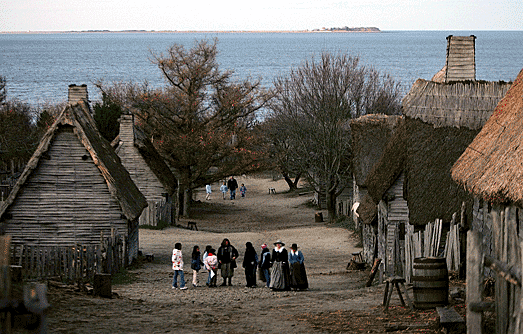
As happened elsewhere in the colonies, a group of upper class men
founded The Old Colony Club in Plymouth in 1769. They held an annual
dinner and speech on
Forefathers' Day in December to mark the anniversary of the Pilgrims
landing. From then on, the people of Plymouth, as well as Boston and
New York, regularly celebrated Forefather’s Day.
By the mid-19th century, the popularity of Forefathers' Day began to
fade—only the town of Plymouth continued to celebrate it on December
21—while the importance of Thanksgiving grew. After 1890,
representations of the Pilgrims began to reflect a shift of interest
to the 1621 harvest celebration. That event which we now call the
"First Thanksgiving" came to symbolize the union of prosperity and
brotherhood as school teachers taught a stylized version of the
event.
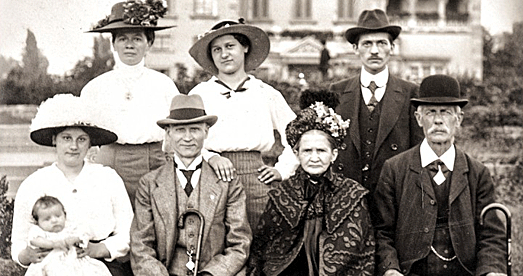
As time went on, each succeeding generation added it’s own spin on
the story of the first Thanksgiving until it evolved into the
holiday we know today. Together with the paper turkeys, cutout
Pilgrims dressed in black, gray, and white, cranberry sauce, and
afternoon football games, Thanksgiving has truly become an
all-American holiday.
